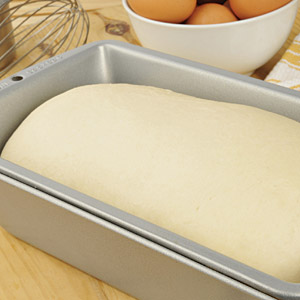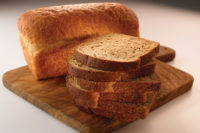Bread is often fortified with dietary fiber of various origins to meet “good” and “excellent” source-of-fiber claims. But while incorporating soluble fiber at the elevated levels needed to fulfill such claims, the high water-binding capacity characteristic of fiber can cause undesirable rheological changes to dough, namely stickiness and poor machinability, which can result in bread with low loaf volume and a coarse, crumbly texture. This occurs because the additional fiber dilutes the protein content, which stresses the gluten network and reduces gas retention.
Reinforcing the gluten network by adding vital wheat gluten or using a high-protein spring wheat flour are possible approaches to improving the volume and texture of high-fiber breads.
Another option is to find a more functional fiber. Fibersym RW is a Type 4 resistant starch (RS4) produced by MGP Ingredients Inc., Atchison, Kan., by cross-linking starch granules using a phosphorylation technique. (Phosphorylation means adding a phosphate group to a protein or other organic molecule.) The resulting starch is indigestible because mammalian enzymes cannot reach into the starch’s compact structure, which is highly restricted to swelling.
RS has health benefits similar to dietary fiber consumption: Colon cancer prevention; cholesterol reduction; and blood glucose attenuation. Since Fibersym RW is a fine white powder with a bland flavor, it has a low water-holding capacity (similar to flour) and doesn’t significantly affect dough-handling properties. It’s theoretically suitable for increasing the fiber content of bread.
As a side project to my thesis research, I put Fibersym to the test in white pan bread. I baked and analyzed bread with 0, 5, 10, 15, 20 and 25% of the flour replaced by Fibersym to evaluate the influence of this resistant starch on dough characteristics, bread crumb quality, shelf life, total dietary fiber (TDF) content and consumer acceptability. The protein content remained the same for all treatments, due to vital wheat-gluten supplementation.
Mixograph and baking water absorption (see “The powerful WAT-tage of ‘wonder wheat’” in the November 2013 issue of SF&WB) remained the same as the control (62%) for dough containing 5, 10 and 15% RS4; however, a significant increase in absorption (64%) occurred with 20 and 25% RS4. The 25% RS4 dough required the longest mixing time (3.75 minutes), which is still acceptable for commercial production.
Dough strength wasn’t significantly affected until it reached the 25% inclusion level, and I saw no significant effect on the dough extensibility. The highest application level exhibited a lower loaf volume than the control.
Fibersym incorporation had a marginal effect on crumb grain quality. Image analysis of the crumb structure showed no significant difference in the number of cells between loaf treatments. The significantly smaller average cell wall thickness, cell diameter and cell volume of the loaves containing 25% RS4 indicated that the depressed loaf volume was a result of less cell expansion, rather than cells combining.
During the two-week, shelf-life study, I found no difference in crumb firmness or elasticity between RS4 treatment levels within the test days. Based on these results, I found that RS4 can be added to white pan bread at levels of up to 25% without influencing product shelf life.
As the RS4 usage level increased from 0 to 25%, the bread’s TDF content rose from 2.9 to 9.2%. Loaves with 15, 20 and 25% RS4 qualify for the FDA’s “Good Source of Fiber” claim by providing 10 to 19% of the daily recommended value (DRV) of 25 g. of fiber per 50-g. serving size of bread.
A study with 98 volunteer panelists showed no significant difference in bread flavor between the control and RS4 levels evaluated (15, 20 and 25%).
A large proportion of the participants (87.2%) reported that they would purchase bread with a “good source of fiber” claim. Because the vast majority of the participants surveyed reported daily (69.1%) or at least once-a-week (24.7%) bread-consumption patterns, and the consumer evaluation scores of bread with and without RS4 were very similar, I concluded that RS4 inclusion in bread is a feasible avenue for increasing fiber intake in the American diet. Resistant starches like Fibersym can be added at levels up to 20% without adversely affecting dough and bread quality, while increasing TDF content 153%. In short, I’d say it passed the test!
Elyse Buckley is a Master of Science candidate student in the grain science department at Kansas State University, Manhattan, Kan. She studied abroad last year and had an internship with Flowers Foods in 2009, spending time on a production line and in research and development. She will continue with her bakery studies and offer her observations and impressions of an education in baking.




